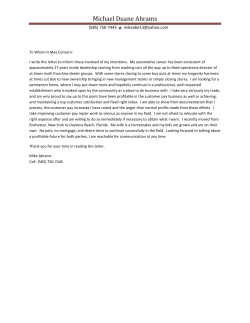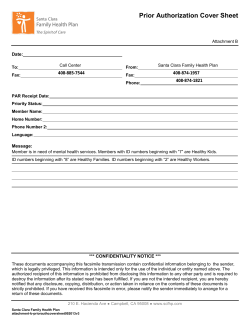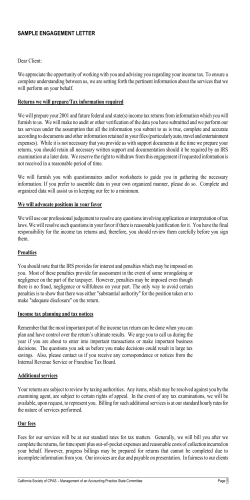
Successful Business Plan The
TM THE BEST-SELLING BUSINESS PLAN GUIDE Completely Revised & Updated! “User-friendly and exhaustive… highly recommended.” — Forbes Magazine The Successful Business Plan SECRETS & STRATEGIES Rhonda Abrams foreword by legendary venture capitalist Eugene Kleiner Fourth Edition ◆ Insider secrets from top venture capitalists and successful business owners and CEOs ◆ Easy “Flow-Through Financials" for fast forecasting ◆ An outstanding sample business plan you can emulate ◆ A special chapter on starting a business in a weak economy ◆ The latest research and trends in business planning and financing ◆ Dozens of worksheets cover every phase of developing a winning business plan The Book of Choice at the Nation’s Top Business Schools “An essential tool for building a business from small startup to international giant.” Deborah M. Kinsch, Senior Attorney, Nissan Motors Your step-by-step guide to a more fulfilling business. This book will change the way you think about creating a business plan. NEW IN THIS EDITION ◆ YOU GET EXPERT HELP 183 tips from 16 insiders reveal what most impresses the people who evaluate and fund business plans. Chapter on starting a business in a slow economy “Our #1 best-seller on entrepreneurship every year — it outsells other business plan books 5 to 1.” Kevin Dusek, Stacey’s Professional Bookstore ◆ WORKSHEETS JUMPSTART THE PROCESS 99 worksheets cover all critical plan sections to get you started fast and successfully. “I have a library of business plan books, but this one is my bible.” Daniel B. Scully, Daniel B. Scully Marketing Services ◆ TIPS ON IMPRESSING FUNDERS How to put your facts and figures into a compelling, readable story. “The Successful Business Plan makes simple work of a complex process.” Thomas G. Hood, President & CEO, Southwall Technologies ◆ SAMPLE BUSINESS PLAN GUIDES YOU Written in the accepted wording and style, providing an excellent model. “I put off doing a business plan because it seemed an overwhelming task. But with this book, it was actually quite simple.” Janice Grimes, Redwood Management 52995 9 780966 963564 USA $29.95 Canada $44.95 Expanded, up-todate business research sources & techniques New information on starting a successful Internet-based business Expanded, up-todate information on locating funding sources NOW AVAILABLE Finish your financials faster with the new supplemental electronic worksheets package, designed to work hand-in-hand with this book. Available separately at www.planningshop.com ◆ ADVICE FOR YOUR TYPE OF BUSINESS Special chapters for service, manufacturing, retail, and Internet companies. ◆ THE ABRAMS METHOD OF FLOW-THROUGH FINANCIALS Easily complete your financial projections—even if you’re a numbers novice. ◆ WINNING TIPS FOR COMPETITIONS Entering a biz plan contest? See the special chapter on classes and competitions. ABOUT THE AUTHOR Distributed by Publisher’s Group West ISBN 0-9669635-6-3 TM Rhonda Abrams is the author of The Successful Business Organizer and Wear Clean Underwear: Business Wisdom from Mom and writes the nation’s most widely read small business column, distributed to over 100 newspapers. In 1986 she started a business plan consulting firm, serving both small start-ups and Fortune 500 corporations. Table of Contents About the Author About the Contributors Acknowledgments Foreword by Eugene Kleiner Foreword to the Fourth Edition How to Use This Book Introduction Section I Starting the Process Chapter 1: The Successful Business Getting Your Plan Started Making Your Plan Compelling Chapter 2: Chapter 3: vii ix xv xxiii xxv xxix xxxiii 1 13 35 Section II Business Plan Components Chapter 4: Chapter 5: Chapter 6: Chapter 7: Chapter 8: Chapter 9: Chapter 10: Chapter 11: Chapter 12: Chapter 13: Chapter 14: Chapter 15: Chapter 16: Chapter 17: The Executive Summary Company Description Industry Analysis & Trends Target Market Competition Strategic Position & Risk Assessment Marketing Plan & Sales Strategy Operations Technology Plan Management & Organization Community Involvement & Social Responsibility Development, Milestones, & Exit Plan The Financials The Plan’s Appendix 47 59 73 87 103 119 133 155 181 189 211 221 237 283 Copyright © 2003 Rhonda Abrams. For evaluation only. Reproduction of any kind is strictly prohibited. xviii The Successful Business Business Plan: Secrets and Strategies Section III Putting the Plan to Work Chapter 18: Chapter 19: Chapter 20: Chapter 21: Chapter 22: Preparing, Presenting, & Sending Out Your Plan Looking for Money Using Your Plan for Classes & Competitions Internal Planning for Existing Businesses & Corporations Time Saving Tips 289 299 315 327 337 Section IV Special Considerations Chapter 23: Chapter 24: Chapter 25: Chapter 26: Chapter 27: Considerations for Internet, “e-businesses” Considerations for Retailers Considerations for Manufacturers Considerations for Service Businesses Business Planning in a Weak (or Strong) Economy 343 363 369 375 381 Section V Reference Outline of a Business Plan Business Terms Glossary Funding Sources Research Sources Entrepreneurs’ Sources Index 391 395 399 404 411 415 Sample Plan Cover Letter Executive Summary Company Description Industry Analysis and Trends Target Market The Competition Strategic Position & Risk Assessment Marketing Plan Operations Technology Plan Management & Organization Community Involvement & Social Responsibility Development, Milestones & Exit Plan Income Statement, Three-Year Projection 314 55 71 85 99 115 131 152 178 187 207 218 234 275 Copyright © 2003 Rhonda Abrams. For evaluation only. Reproduction of any kind is strictly prohibited. Table of Contents xix Income Statement, Annual Cash-Flow Projection Balance Sheet Sources & Uses of Funds Assumption Sheet 276 278 280 281 282 Copyright © 2003 Rhonda Abrams. For evaluation only. Reproduction of any kind is strictly prohibited. xx The Successful Business Plan: Secrets and Strategies Worksheets, Examples, and Charts in this Book Basic Business Concept 3 The Four C’s 12 Research Questions 17 Research Sources 19 Evaluating Your Business Concept 33 Examples of Charts to Use in Your Business Plan 42 Synopsis Executive Summary Plan Preparation Form 51 Narrative Executive Summary Plan Preparation Form 53 Statement of Mission 62 Legal Issues 65 Company Description Plan Preparation Form 69 Past and Future Growth of Your Business Sector 74 Your Company’s Industries 74 Past and Future Growth of Your Industry 75 Maturity Characteristics of Your Industry and Associated Opportunities/Risks 76 Industry Maturity Chart 77 Effects of Economic Conditions on Your Industry and Business 78 How Seasonal Factors Affect Your Industry 79 Technological Change in Your Industry Over the Last Five Years 80 How Sensitive Is Your Industry to Government Regulation? 81 Supply and Distribution Channels in Your Industry 82 Financial Patterns 83 Industry Analysis Plan Preparation Form 84 Demographic Description 90 Geographic Description 91 Psychographic Description 92 Lifestyle/Business-Style Description 93 Purchasing Patterns Description 94 Buying Sensitivity Description 95 Market Size and Trends 96 Target Market Plan Preparation Form 98 Competitive Analysis: Customer Perception Factors 106 Competitive Analysis: Internal Operational Factors 107 Market Share Distribution 110 Future Competition and Barriers to Entry 113 Copyright © 2003 Rhonda Abrams. For evaluation only. Reproduction of any kind is strictly prohibited. Table of Contents xxi Competition Plan Preparation Form 114 Risk Evaluation 128 SWOT: Strengths/Weaknesses/Opportunities/Threats 129 Strategic Position Plan Preparation Form 130 The Five F’s 136 Marketing Vehicles 138 Marketing Tactics 140 Sales Force 144 Sales Process and Productivity 145 Marketing and Sales Strategy Plan Preparation Form 147 Monthly Marketing Budget 148 Monthly Sales Projections 150 Facilities 158 Production 162 Equipment Schedule 164 Inventory Control 166 Supply and Distribution 168 Order Fulfillment and Customer Service 170 Research and Development 171 Financial Control 173 Other Operational Issues 174 Start-Up Costs 176 Operations Plan Preparation Form 177 Technology Budget 185 Technology Plan Preparation Form 186 Key Employee Evaluation 192 Compensation and Incentives 195 Board of Directors/Advisory Committee 197 Professional Services 199 Key Management Personnel to Be Added 200 Examples of Flow Charts 202 Management Style 205 Management Plan Preparation Form 206 Social Responsibility Plan Preparation Form 216 Company Vision 223 Copyright © 2003 Rhonda Abrams. For evaluation only. Reproduction of any kind is strictly prohibited. xxii The Successful Business Plan: Secrets and Strategies Worksheets, Examples, and Charts in this Book (continued) Priorities 225 Milestones Achieved to Date 227 Future Milestones 228 Exit Plan Options 232 Development Plan Preparation Form 233 Abrams Method of Flow-Through Financials 240 Staffing Budget 248 Monthly Cash Income Projections 250 Income Statement: Historical 252 Income Statement: Annual by Month 254 Income Statement: Annual by Quarter 256 Income Statement: Annual for Five Years 257 Cash Flow History 260 Cash-Flow Projection: Annual by Month 262 Cash-Flow Projection: Annual by Quarter 264 Balance Sheet 265 Sources and Use of Funds 267 Break-Even Analysis 270 Assumption Sheet 272 Nondisclosure Agreement 291 Your “Elevator Pitch” 310 Sources of Debt Financing 312 Sources of Equity Financing 313 Team Process Checklist 324 Assignment Sheet 325 Key Ratio Analysis 334 Key Customer Analysis 336 ‘e-Business’ Business Model 347 Front-End Issues 353 Back-End Issues 357 Copyright © 2003 Rhonda Abrams. For evaluation only. Reproduction of any kind is strictly prohibited. Chapter 7 Target Market It’s easier to get a piece of an existing market than it is to create a new one. Know Your Customers Essential to business success is a thorough understanding of your customers. After all, if you don’t know who your customers are, how will you be able to assess whether you are meeting their needs? Since success depends on your being able to meet customers’ needs and desires, you must know who your customers are, what they want, how they behave, and what they can afford. Is Your Company Market Driven? Moreover, if you are using your business plan to secure financing, defining the nature and size of your market is critical. Many investors look for companies aimed at substantial-sized markets and that are market driven. In other words, they seek to fund companies whose orientation is shaped by the demands and trends of the marketplace rather than the inherent characteristics of a particular product or service. Being attuned to your market may lead you to make changes in your advertising, packaging, location, sales structure, even the features and character of the product or service itself. In the long run, a market analysis will save you money. When deciding which marketing vehicles to use (advertising, trade shows, etc.), you can then choose approaches based on whether they reach your specific target market. “You have to be market driven. Who will buy it? What do they feel about it? Do they think it’s a luxury or commodity? Do they need a big bottle or a small bottle? Particularly with a brand new product, you have to understand your market.” Larry Leigon Founder, Ariel Vineyards A market analysis differs from a marketing plan. An analysis enables you to identify and understand your customers; a marketing plan tells how Copyright © 2003 Rhonda Abrams. For evaluation only. Reproduction of any kind is strictly prohibited. 88 The Successful Business Plan: Secrets and Strategies you are going to reach your customers. Laying out a marketing plan is covered in Chapter 10. “Be willing to look at different market segments instead of just the obvious or largest market to secure some degree of market penetration. Take, for instance, the creditcard electronic key for hotels. Even though these keys represented substantial savings, established hotels at first were reluctant to make the change-over from traditional locks. Instead, new hotels were the first to put in this type of lock, and existing hotels followed later, once the benefits were wellknown.” Eugene Kleiner Venture Capitalist If you do not sell your product or service directly to the end-user but rather to retail outlets, distributors, or manufacturers, you have two markets, and you should define the characteristics of both of them — the ultimate consumer and the intermediary who is your actual customer. These target markets may have very different habits and concerns, and you need to understand both of them, as they each affect your sales. For instance, you may sell software you develop to a computer manufacturer who then includes it with the computers they sell to consumers. The computer manufacturer’s biggest concern may be cost; the consumer’s may be ease-of-use. To gather information for this chapter, use the methods discussed in Chapter 2. Defining Your Target Market You may be tempted to describe your market in the broadest possible terms, choosing to include all those who might potentially use your product or service. Doing so gives you the comforting sense that you have a huge market to exploit. Unfortunately, this gives you little genuine information on which to base your business decisions. You could end up defining the market for furniture as everyone who lives indoors, hardly helpful if you’re trying to come up with a marketing plan for your furniture store. Instead you need to identify the particular market segments you wish to reach. These segments describe distinct, meaningful components of the overall market and give you a set of specific characteristics by which to identify your target market. Let’s say you are considering opening a discount dry cleaning establishment. You plan your service to be less expensive and faster, but, as a result, it may also be of slightly less quality than the dry cleaner now serving the area. Thus, you might define your target market in these terms: “Employed women in white-collar jobs, price and time sensitive, commute by car, ages 25 to 50, household incomes of $20,000–$50,000 per year, children living at home, reside in the Laurelwood neighborhood.” You then need to determine whether the neighborhood has enough consumers who fit this profile to support your business. To be a useful planning tool, the definition of your target market must meet these criteria: ■ ■ ■ Definable. It should have specific characteristics identifying what the potential customers have in common. Meaningful. The characteristics must meaningfully relate to the decision to purchase. Sizable. It must be large enough to profitably sustain your business. Copyright © 2003 Rhonda Abrams. For evaluation only. Reproduction of any kind is strictly prohibited. Chapter 7: Target Market 89 ■ Reachable. Both the definition and size must lead to affordable and effective ways to market to your potential customers. Once you have defined your market, you should then assess its size and trends, evaluate your competitors for that particular market, and probe the market for strategic opportunities. Demographic Description Begin describing your market by the most basic, objective aspects of the customer base. These details are the specific and observable traits that define your target market. Demographic information is particularly useful when devising your marketing plan. Many marketing vehicles, such as publications, mailing lists, radio, and TV, accumulate this kind of data about the market they reach. Thus, you are better able to judge whether such vehicles are appropriate for your company. Remember, you want to define those characteristics of your target market that meaningfully relate to the interest, need, and ability of the customer to purchase your product or service. In the previous definition of the target market for the Laurelwood dry cleaner, for instance, the definition “white-collar jobs” directly relates to the need for regular dry cleaning; “women” relates to the fact that most dry cleaning nationally is purchased by women; “commute by car” is important because the location is not near public transportation; and “$20,000–$50,000” relates to the customer’ s ability to pay for dry cleaning while being less likely to afford the more expensive cleaners. On the Demographic Description worksheet on the next page, describe the demographic details of your target market, whether you are marketing to consumers or businesses. Geographic Description Next, define the primary geographic area(s) you intend to serve. This definition should be as concrete as possible, indicating whether your business serves a particular neighborhood, city, state, region, nation, or portion of the international market. Also, look at the density of the area — whether urban, suburban, or rural, and, if customers will be coming to your place of business, indicate whether the location is in a mall, strip center, business district, or industrial area, or will be a stand-alone facility. Some businesses define their geographic market by climate, serving only cold-weather or hot-weather locations. If you are making your product or service available on the Internet, you may be tempted to view the entire world as your geographic target market. However, even on the Internet, there are limitations to which geographic areas are your primary target markets. These limits may be due to issues of fulfillment (e.g., shipping goods) or language, and there are certainly limits of realistic market demand from different areas. “Customers can be categorized in several ways, by income level or by lifestyle issues. The income levels can fall into one or more of the following categories: luxury, upscale, upper moderate, moderate, and budget. Lifestyle issues are more subjective. The target customer is less dependent on income level and more on her attitude about how she spends her disposable income.” Nancy Glaser Business Strategies Consultant “It’s very difficult to create a new market, even if there’s a need. Developing a new market takes years, even if you’re 100% right about the need and the product. The best market to look for is a market that already exists, that is already being served, but being served in a marginal fashion.” Eugene Kleiner Venture Capitalist Copyright © 2003 Rhonda Abrams. For evaluation only. Reproduction of any kind is strictly prohibited. 90 The Successful Business Plan: Secrets & Strategies Demographic Description Consumer Age Range: Business Industries: Income Range: Sector: Sex: Years in Business: Occupation: Company Revenues: Marital Status: Number of Employees: Family Size: Number of Branches: Ethnic Group: Square Footage: Level of Education: Company Ownership: Home Ownership: Other: Other: Copyright © 2003 Rhonda Abrams. For evaluation only. Reproduction of any kind is strictly prohibited. Chapter 7: Target Market 91 On the worksheet below, describe the geographic details of your target customers, whether consumers or businesses. Geographic Description Area Served (city, region, nation, etc.): Density (urban, rural, suburban, etc.): Nature of Location (mall, strip center, business district, etc.): “The decision to locate in Napa was a marketing decision. We could have made our product anywhere, but Napa is associated with premium wines. We wanted Napa on the label.” Larry Leigon, Founder, Ariel Vineyards Climate Conditions: Lifestyle/Business-Style Description In the Target Market section of your plan, convey a sense of the concerns and interests of your customers. How do they spend their time? What issues are they facing in their lives or businesses? With whom do they associate? How do they relate to their employees and community? Your natural instincts and experience with customers gives you some sense of what your customers are interested in. It’s logical, for instance, to assume that receptive targets for your expensive specialty food product are fairly likely to subscribe to Gourmet or other food magazines and might belong to local food and wine organizations. Or, if the market for your business service is law firms, you would naturally assume they belong to the local Bar Association. A little research can help you identify other aspects of your target market’s lifestyle or business style. Observe customers in places where they shop or live. What other products or services do they buy? What kinds of cars do they drive? What kinds of clothes do they wear? The remainder of this chapter will help you identify your target market’s psychographics, purchasing patterns, buying sensitivities, and market size and trends. At the end of the chapter, the Sample Plan shows you exactly how to put these findings into a clear, compelling write-up in your business plan. Copyright © 2003 Rhonda Abrams. For evaluation only. Reproduction of any kind is strictly prohibited. GET YOUR PLAN FINISHED FASTER WITH Electronic Financial Worksheets Designed from the ground up to work handin-hand with The Successful Business Plan: Secrets & Strategies! Worksheets are identical to those found in the book—no new formats to wrestle with! All the math and calculations are done for you! “Help Balloons” provide convenient information and advice, and refer you to the relevant pages in the book for further information. Built on Microsoft Excel, the powerful industry standard for generating compelling financial reports. Fill out the information in one worksheet and it automatically transfers to other appropriate worksheets. Designed for readers of this book! Now you can easily complete the financial worksheets for your business plan on your computer! The Planning Shop has developed this Excel-based package of worksheets and financial statements to work hand-in-hand with your copy of this book. Charts and graphs are automatically generated for you! When you’re finished, just print out your Income Statement, Cash Flow Projections, and Balance Sheets and add them to your plan! True “Flow-Through Financials” Taking the flow-through technique Rhonda uses in this book one-step further, now you can enter your financial figures just once, and they’ll automatically flow-through to all the other relevant statements, performing necessary calculations along the way! Download your copy today at our lowest price: www.PlanningShop.com/worksheets
© Copyright 2025











